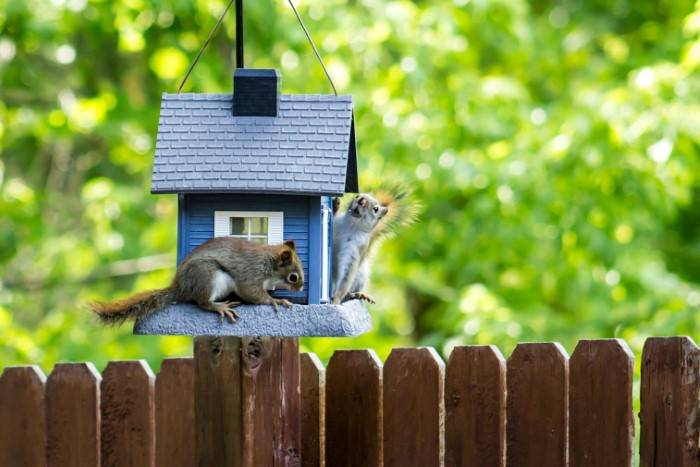Bird feeding is a joyous pastime that brings the beauty and melody of wild birds into our yards and gardens. However, for many bird enthusiasts, the presence of squirrels can quickly turn this tranquil activity into a frustrating battle of wits. These agile and persistent creatures are notorious for raiding bird feeders, devouring seeds meant for our feathered friends, and sometimes even damaging the feeders themselves. In response to this challenge, a range of squirrel-proof bird feeders has been developed, offering innovative solutions to keep squirrels at bay while still providing nourishment to our avian visitors. In this comprehensive guide, we’ll explore the world of squirrel-proof bird feeders, from their design features and effectiveness to tips for selecting and using the right feeder for your garden.
Understanding the Squirrel Challenge
Squirrel Behavior:
Squirrels are highly adaptable rodents known for their agility, intelligence, and relentless persistence when it comes to accessing food sources. They can jump, climb, and even chew through various materials to reach bird feeders, making them a formidable adversary for bird enthusiasts.
Feeder Raids:
Squirrels are notorious for raiding bird feeders, often emptying them within minutes and leaving little for the intended avian visitors. Their presence can discourage birds from feeding and even cause damage to feeders, leading to frustration and disappointment for bird lovers.
Features of Squirrel-Proof Bird Feeders
Baffle Design:
Many squirrel-proof feeders feature baffles or domes designed to thwart squirrels’ attempts to access the seed. These obstacles are positioned above or below the feeder, making it difficult for squirrels to reach the feeding ports or perches without encountering an obstacle.
Weight-Activated Mechanisms:
Some squirrel-proof feeders are equipped with weight-activated mechanisms that close off access to the seed ports when a squirrel’s weight is detected. This innovative feature ensures that only lighter birds can access the feeder while preventing heavier squirrels from getting a free meal.
Wire Cages and Mesh Guards:
Another effective design feature found in squirrel-proof feeders is the inclusion of wire cages or mesh guards surrounding the seed reservoir. These barriers allow smaller birds to access the seed while keeping larger squirrels at bay, providing a safe and secure feeding environment for birds.
Adjustable Perches:
Certain squirrel-proof feeders come with adjustable perches that can be configured to accommodate the weight of different bird species while closing off access to heavier intruders like squirrels. This versatility ensures that birds can feed comfortably while deterring unwanted guests.
Types of Squirrel-Proof Bird Feeders
Tube Feeders:
Tube feeders are a popular choice for bird enthusiasts, offering a versatile and efficient way to dispense seeds to a variety of bird species. Squirrel-proof tube feeders often feature metal cages or adjustable perches to prevent squirrels from accessing the seed.
Hopper Feeders:
Hopper feeders, also known as house or platform feeders, are designed to hold larger quantities of seed and attract a wide range of bird species. Squirrel-proof hopper feeders may incorporate weight-activated mechanisms or adjustable perches to deter squirrels.
Nyjer Seed Feeders:
Nyjer seed feeders are specifically designed to dispense tiny nyjer seeds, which are favored by finches and other small songbirds. Squirrel-proof nyjer seed feeders typically feature narrow feeding ports and wire mesh guards to prevent squirrels from accessing the seed.
Suet Feeders:
Suet feeders are designed to hold blocks or cakes of suet, a high-energy food source made from rendered animal fat. Squirrel-proof suet feeders often feature wire cages or baffles to protect the suet from squirrels while allowing birds to feed.
Squirrel Proof Bird Feeders
Tips for Selecting and Using Squirrel-Proof Bird Feeders
Choose Quality Materials:
Look for squirrel-proof feeders made from durable materials such as metal, heavy-duty plastic, or powder-coated steel. These materials are resistant to chewing and weathering, ensuring long-lasting performance.
Placement Matters:
Position your bird feeder in a location that is difficult for squirrels to access, such as away from trees, fences, and other potential launch points. Consider using a pole-mounted or hanging feeder with a baffle or dome to further deter squirrels.
Regular Maintenance:
Keep your bird feeder clean and well-maintained to prevent damage and ensure optimal performance. Regularly remove spilled seed and debris, and clean the feeder with mild soap and water as needed to prevent mold and bacterial growth.
Monitor Feeder Activity:
Keep an eye on feeder activity to ensure that birds can access the seed without interference from squirrels. Adjust feeder settings or relocate the feeder if squirrels continue to pose a problem.
Related Post:
What is the State Bird of Nebraska
Can You Feed the Birds Without Attracting Mice
Squirrel-proof bird feeders offer a practical solution for bird enthusiasts seeking to enjoy the beauty of wild birds without the nuisance of pesky squirrels. By incorporating innovative design features and effective deterrents, these feeders provide a safe and inviting environment for birds to feed while keeping squirrels at bay. Whether you prefer tube feeders, hopper feeders, or suet feeders, there is a squirrel-proof option available to suit your needs and preferences. So, embrace the joy of bird feeding with confidence, knowing that your feathered friends can enjoy a meal without interruption from their furry counterparts. With the right feeder and a little ingenuity, you can create a backyard oasis that attracts a diverse array of bird species while keeping squirrels at a respectful distance.




